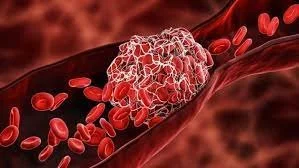According to new research published in the online journal BMJ Open, men with prostate cancer had a 50% higher chance of having major and potentially fatal blood clots within the five years following their cancer diagnosis than men of the same age who do not have prostate cancer.
Although the risk is not as high as other types of cancer, experts are advising practitioners and patients to be aware of the danger in order to provide appropriate diagnosis and treatment if a blood clot occurs.
This is significant because venous thromboembolism (VTE), the kind of blood clot studied, is a leading cause of death among cancer patients, with the risk being higher in those with more advanced disease. People with cancer are more likely than non-cancer patients to develop venous thromboembolism (VTE), which are severe but curable blood clots in the veins. The risk varies depending on the type of cancer and its stage. VTEs are the major cause of patient death.
Because prostate cancer is the most common malignancy in middle-aged and older men, men with prostate cancer are at risk of developing VTE.
According to some older research, the risk of VTE is two to three times higher in men with prostate cancer than in men of similar age without the disease.
However, the researchers requested more recent data due to the substantial changes in how men with prostate cancer are managed over the last decade. This includes the widespread use of newer antiandrogens as well as anticoagulant medications for other ailments that may reduce the risk of VTE.
A group of European researchers conducted a large-scale study using nationwide data from males in Sweden collected between 2007 and 2017 to compare the occurrence of VTE among 92,105 men with prostate cancer and 466,241 men of the same age who did not have prostate cancer (the comparison group).
They discovered that 3.2 percent of men with prostate cancer had a VTE within five years of their cancer diagnosis, compared to 2.1 percent of men in the comparison group.
They projected that around seven men with prostate cancer would develop a VTE each year, compared to approximately four men without prostate cancer.
After accounting for factors that could influence VTE risk in their analysis (such as the presence of cardiovascular disease and socioeconomic factors), the researchers discovered that men with prostate cancer had a 50% higher risk than those in the comparison group over the five-year study period, with the most dangerous period being the first six months after a cancer diagnosis.
Because this was an observational trial, it is unclear how much of the elevated risk was caused by prostate cancer and how much was caused by other variables between the two groups of men that could have altered VTE risk but could not be controlled for. One weakness of the study, for example, was the lack of information on smoking status and alcohol consumption.
However, this was a large study, and the data sources employed (a variety of national registers) were recognized to be of high quality. Because the study used data from men across Sweden, the findings are likely to be an accurate picture of VTE risk in men with and without prostate cancer. "The degree of increased VTE risk reported in our analysis among men with prostate cancer is lower than that seen in prior studies for other cancer types, and is likely owing to the high proportion of individuals with localized illness and at low risk of cancer progression," the scientists stated.
"However, clinicians treating men with prostate cancer should be aware of the significant increase in VTE risk in these men, particularly in the first six months after a cancer diagnosis, to help assure timely VTE diagnosis."
BMJ Open
DOI



